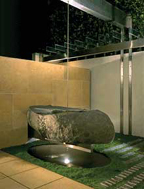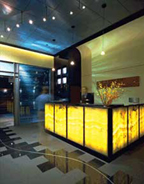

Lundberg is the founder and CEO of Lundberg Design, which he established in January of 1987. The firm's work encompasses a wide variety of project types, including residences, hotels, restaurants and wineries as well as corporate designs for high-profile firms such as Oracle. And while Lundberg's use of stone varies for each project, a common thread is the application of the material as a three-dimensional design element, a vestige of his early years as a sculptor. Lundberg received a B.A. in Sculpture and in English Literature from Washington & Lee University, and he received his M.Arch from the University of Virginia.
Since Lundberg Design was founded, it has received numerous awards in the field. The San Francisco Chapter of the American Institute of Architects (AIA) has cited Lundberg Design on several occasions, including the "Small Firms, Great Projects" Award in 1991 and an AIA Honor Award for a residential project in 1997. Additionally, the firm has won numerous public arts competitions as well as other honors over the past 15 years.
Contemporary Stone & Tile Design met with Lundberg in a conference room overlooking the firm's workshop in San Francisco, CA.

Lundberg: Before I got into architecture, I had degrees in English literature and sculpture. And when I was doing sculpture, I tended to concentrate on stone and metal. Most of my work at the time was carving, so I was working with stones that were relatively easy to manipulate, such as marble. That experience has continued to some extent throughout our work. We periodically get involved in doing artwork. Most of it is large-scale public art, and we have used some stone for that. Of course, as a result of those experiences, I became familiar with the properties of marble, and I have an affinity for stone. In general, I like natural materials. I am not fond of veneer; I like materials that have substance and weight. So when we use stone, we tend to try to express it as a material of weight; to not use it as a veneer, but to really showcase the thickness and the massive qualities of stone. I think all of that comes from working as a sculptor.
CSTD: What are some of the ways in which you would detail a stone to take advantage of its three-dimensional qualities?
Lundberg: The first thing is that we tend not to use stone much in polished slab format. If you're only using polished stone, it tends to start reading as a veneer. So we like finishes that express the depth of it a little bit more. We used a honed finish a lot. Typically, on our counters, we use honed material rather than polished. On our walls, we use even more textured stone, and sometimes we go with carved stone. We did a bathroom where we used Giallo Sophia, a Bulgarian limestone with a chiseled edge. That's the kind of thing that we're often looking for. Stone is still primarily sold in sheet format for economic reasons. While it would be great to deal with giant blocks of stone all of the time, it's hard to get every client to pay for that. But we're always looking for unique expressions of stone. We're just doing a project now in Oakland where we are using slate on a wall, and we are using the back side of the slate. They had scored it with multiple saw cuts to grab the adhesive, and we just flipped the stone around, and that is the side we are exposing.
CSTD: What type of client was that?
Lundberg: That is a developer, and he has a really ordinary office building in downtown Oakland. He wants to add sex appeal to it, so we're the "sex appeal consultants," and we're trying to do something different and punchy. It's a very unusual lobby in that it runs through the entire building, and it kind of jogs in the middle and turns. So we took this image of a river and tried to turn it into a much more serpentine pattern. And the idea of the scored stone was ideally something that would recall the sedimentary layers of stone as a river cuts through it, and that's why we used it.
CSTD: What types of clients do you typically work for?
Lundberg: The only common characteristic that our clients have is that they all like modern architecture. We try not to specialize in anything. We do a lot of custom homes, but the nice thing about homes is that they are infinitely varied. We also do a lot of other work, but it doesn't tend to fall into categories. We have done a hotel; we've done a winery; we've done a restaurant; and we've done offices; we once did a cave. So we always try to make sure we're doing a wide variety of work. I find that our most innovative work is on projects where we've never done one before, because we don't have any preconceptions going in.
CSTD: What are some of the practical lessons about stone that you have learned in your work?
Lundberg: Stone is a really straightforward material. One of the nice things is that it is very predictable. People have been working with it forever. We have learned to listen to dealers and the fabricators because they know a lot more about it than we do. Generally, if you talk to the people in the field and get their input -- and if you try to express your intent -- usually they will solve the problems from a technical point of view. You will find people that think you're crazy occasionally, like when we are trying to mount slate backwards, but they are generally able to find solutions. I have [been hesitant] to use marble for kitchen countertops. Of course, we have done some in marble, and sealers have gotten much better since we began using stone, but I still like using granite on counters because it is a better surface. It will hold up to anything, whereas marble won't. And so you're constantly trying to alter the characteristics of the marble to make it work, and I would rather use stone in ways that it wants to be used, as opposed to trying to fight the material all the time. That's inherent in our work; hopefully, the material is the right choice for the application.
CSTD: You mentioned that you have done some designs that pushed the envelope a bit. Are you finding yourself educating clients on what can be done with stone?
Lundberg: All of our clients are looking for something out of the ordinary. If they weren't, they wouldn't be coming to us. So we're always looking to reinvent the wheel. And so I guess we're educating our clients to some extent. But they're kind of hoping to be surprised. We're often educating ourselves, because we are always trying to push the material. As you can see here [in our offices], we have a workshop that we use as a laboratory for testing out ideas and figuring out if something will work. For one residence, we did a fountain in a 10,000-pound Academy Black granite boulder that is suspended from a cable. The water comes down the cable and spills over the sides and into a bronze casting of what used to be the bottom of the boulder. We certainly educated ourselves on that project, but it worked. It's a constant education process, because we're not really interested in doing something we've done before. We're always trying to come up with new ideas, and that's why we're interested in working with stone suppliers that are willing to listen to us. Some people just want to sell slabs and that's it.
CSTD: What have been some of your most positive experiences working with stone?
Lundberg: I can tell you that the boulder fountain was one of my favorite projects working with stone. We also did a pool project in Napa where we used a green slate from China in slab form for the coping and all of the stairs, and then we used it as tile for the rest of it. It's a great monolithic sea of green slate. The pool is 100 feet long with a big infinity edge, and the slate has a great solid sense to it. The whole composition of it works because the green slate sort of disappears into the grass, and the water disappears into the horizon. It's really a seamless project that you could have never achieved with another material. We even had a bench in the pool, we ran the slate down into the bench so it cascades into the pool. We did Oracle's main lobby when they did their headquarters. We were brought in after the base building had been designed, and so the interior palette of materials had already been chosen. They were using a greenish granite in 2-foot-square tiles throughout the lobby, and we were brought in to design the furniture and the interiors. We ended up ordering blocks of granite that were 2 feet tall, which was the same size as the tiles. So we pulled up certain tiles and inserted these blocks into the space. And these blocks were the framework for holding the benches and table. One thing that was curious was that we wanted the blocks to have a chiseled face, so they would be polished on three sides, and one face would have a natural break. But we couldn't get the Italian [fabricators] to understand what we wanted. They couldn't understand why we wanted to polish the whole block and then take a piece off. So we had them ship the blocks to Oracle's lobby fully polished. We uncrated one of the blocks, and I took a big sledgehammer and busted off a corner. So security came running out, because they thought we were vandalizing the material. But once I explained that I was the architect, we got everything straightened out, and it was a really cool project. Again, there was an example of somebody basically using stone as a veneer on the floor, we were able to take the blocks and break them to show the natural finish in contrast to the polished finish. With that play of rough and smooth, and the color of the broken stone versus the polished stone, suddenly you understood the character of the stone and you saw the three-dimensional qualities. That still stands out as one of our best stone projects.
CSTD: Can you point to any negative experiences working with stone, in terms of performance or otherwise?
Lundberg: The only negatives we've ever had in terms of performance of stone are just technical issues that we didn't anticipate -- either a sealer problem or something staining. We did a project with limestone paving a few years ago, and it was a steel frame house because it needed to float above all of these trees. It's almost a tree house, and it had 10-foot bays with structural steel running through it on the floor. We were laying the limestone, and one day we came back and there were cracks down every one of those bays. Fortunately, we were only a quarter of the way through the stone installation, but it was very clear that the steel was moving enough that the limestone -- which was relatively weak -- was going to crack. We ended up pulling the limestone up, and we used a rubber isolation membrane between the stone and the structure, which worked great. We've never had any cracking since. In that case, we weren't pushing the stone so much; we were really pushing the architecture, and sometimes you run into situations like that. But in general, because of stone's predictability, it is a very forgiving material in some ways. Certainly, its performance shouldn't surprise you.
CSTD: You have combined stone with metal in your work. Can you describe some of the ways in which you have done that?
Lundberg: We've used it a lot in furniture. We've do a lot of custom furniture, so often we will use metal -- mostly stainless steel -- as a kind of armature for holding the stone. At Oracle, we had these big core holes drilled through the blocks, and then we ran a steel beam between the blocks. We actually set the steel beam in a pot metal; we cast metal into it to hold it within those and only filled it up halfway. That was one attachment, but a more typical attachment is epoxy. For the boulder fountain, we saved the portion of the stone that we sawed off, and we used it for another residence as a landscape table. So you have the natural bottom of the stone, and we polished the saw-cut side. Then you have that great contrast between the polished and the rough-faced material. And we epoxied three stainless steel legs on it, which makes it look sort of like a hovering slab of stone.
CSTD: Have you ever visited the stone quarries?
Lundberg: Yes, I have been to quite a few quarries. As a kid growing up in New England, there were lots of quarries around. We had slate quarries and marble quarries, most of which were abandoned, so we used to swim in quarries all the time. I have been to the Mankato quarries in Minnesota, and I was also at one or two of the quarries in Carrara, Italy, which are fascinating. I was at the Academy Black and Sierra White quarries outside of Fresno for granite.
CSTD: When you go to the quarries, do you actually pick out specific blocks for a project, or is it to get a better understanding of the material?
Lundberg: At the Mankato quarry, I was looking for material for a residence. We were using it for flooring, and we picked out specific stone. But at the same time, I am always looking to the next project, and I also bought a big stone slab there, which I used for a table at another residence. It was actually a slab that they had rejected because it was too flamboyant. It was sitting over on the side, and I asked, "How much to throw that on the truck as well?" I think it was a pretty good deal. Mankato is a beautiful stone. I keep wishing we could use it more, but it can be expensive. You see a lot of it in Chicago. They can do a hand-chiseled face on pretty big panels, and it's a very rusticated look, very similar to the old hand-chiseled base stone they used in a lot of Chicago buildings. We used some of that on the exterior entry wall for a residence. For a limestone, it is extraordinarily colorful. The stone really has three colors. They have a yellow, and there is almost an orange, and then there is a gray. Some of the stones have a mixture of all three in them.
CSTD: Do you have any preferred stones, or does it change from project to project?
Lundberg: We're always looking for new stones. My favorite is always changing. We use a lot of honed black granite, just because it is very simple. So when we're trying to make a minimalist statement, that will be our "default" stone. But currently, I am real hot on some of the Burlington slates from England. We're using it on a residence for all of the counters throughout. I tend to stay away from really wild stones, unless we're doing something like an onyx that we're using as a translucent material. I really like that quality of onyx. We did a hotel here in San Francisco, called the Hotel Diva, where we used the onyx as the base of the reception counter. And we lit it from behind. The cool thing is that everyone who is checking in looks tan, which is sort of appropriate for people checking into a hotel. But I am not generally looking at really flamboyant stones with wild colors and veining. Our palette tends to be more muted and more monolithic. Sometimes we may use [a more flamboyant stone] to contrast, but out palette leans towards more muted materials.